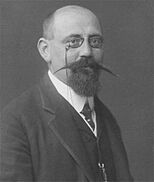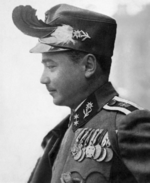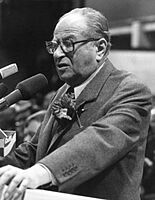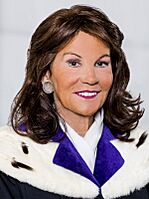List of chancellors of Austria facts for kids
- Renner was the first chancellor of German-Austria, the First Republic, and the Second Republic.
- Dollfuss turned the First Republic into a dictatorship.
- Kreisky is considered perhaps Austria's most successful Socialist leader and also the longest serving Chancellor.
- Bierlein was Austria's first female Chancellor.
The Chancellor of Austria is like the main leader of the Austrian government. This person is chosen by the President and is seen as the country's top manager. The Chancellor leads meetings of the Cabinet, which is a group of important government officials. The Cabinet also includes the Vice-Chancellor and other ministers.
Contents
How Austria's Chancellors Began
After World War I, the role of Chancellor was created on October 30, 1918. It was first called the "state chancellor" of German-Austria. Karl Renner was the very first person to hold this position.
Later, other countries did not allow German-Austria to join with Germany. So, Austria became the First Austrian Republic, a federal country. The title then changed to "federal chancellor." Michael Mayr was the first federal chancellor.
Changes in Leadership
Ten chancellors served during the First Republic. Then, Chancellor Engelbert Dollfuss changed Austria into a country with a very strong, single-person rule. After Dollfuss was killed by Austrian National Socialists, Kurt Schuschnigg became chancellor. He continued the strong rule.
Schuschnigg was later replaced by Arthur Seyss-Inquart, who was a Nazi leader. He was chancellor for only two days before Austria became part of Nazi Germany.
Austria Under Nazi Germany
When Austria was part of Nazi Germany, it lost its own government system. It was managed by German officials. In 1940, Austria was even renamed "Ostmark" and lost all its independence.
After Vienna was freed and Nazi Germany gave up in 1945, Austria became a republic again. However, other countries still had control over Austria until 1955.
Main Political Parties
Since Austria became a republic, two main political groups have been very important. These are the People's Party (ÖVP) and the Social Democratic Party (SPÖ).
The People's Party and its earlier version have led many governments. The Social Democratic Party and its earlier version have also led many governments. Other parties have joined these main parties in government, but they have not led the country themselves.
Choosing a New Chancellor
After an election, or if the Chancellor's job becomes empty, the President usually chooses the leader of the biggest party in Parliament to be the new Chancellor. The President also appoints other government members based on the Chancellor's suggestions.
If a Chancellor dies, quits, or cannot do their job, the Vice-Chancellor steps in as acting Chancellor. If the Vice-Chancellor is also unavailable, other government members take over based on their rank.
Longest and Shortest Terms
Bruno Kreisky was the Chancellor for the longest time, serving over thirteen years. On the other hand, Arthur Seyss-Inquart was Chancellor for the shortest time, only two days. Walter Breisky was the shortest-serving acting Chancellor, holding the job for just one day.
Chancellors
![]() Acting chancellors
Acting chancellors
|
|
|||
|---|---|---|---|
Austrian People's Party / Österreichische Volkspartei (ÖVP)
|
Social Democratic Party of Austria / Sozialdemokratische Partei Österreichs (SPÖ) |
Freedom Party of Austria / Freiheitliche Partei Österreichs (FPÖ) |
Alliance for the Future of Austria / Bündnis Zukunft Österreich (BZÖ)
Communist Party of Austria / Kommunistische Partei Österreichs (KPÖ) The Greens / die Grünen Independent / unabhängig |
|
|
|||
|---|---|---|---|
| 1920–1934: Greater German People's Party / Großdeutsche Volkspartei (GDVP) | 1922–1934: Rural Federation / Landbund (LBd)
1920–1936: Homeland Guard / Heimwehr |
1933–1938: Fatherland Front / Vaterländische Front (VF) | 1920–1945: National Socialist German Worker's Party / Nationalsozialistische Deutsche Arbeiterpartei (NSDAP) |
| No. | Portrait | Name (born–died) |
Term of office | Party | Elected | Cabinet coalition |
Ref. | |||
|---|---|---|---|---|---|---|---|---|---|---|
| Took office | Left office | Time in office | ||||||||
| 1 | 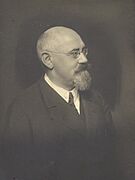 |
Karl Renner (1870–1950) |
30 October 1918 | 7 July 1920 | 1 year, 251 days | SDAPÖ | 1919 | Renner I–II–III • SDAPÖ • CS • GDVP |
||
| 2 | 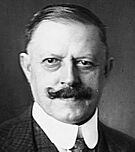 |
Michael Mayr (1864–1922) |
7 July 1920 | 21 June 1921 | 349 days | CS | 1920 | Mayr I–II • CS • SDAPÖ |
||
| 3 |  |
Johannes Schober (1874–1932) |
21 June 1921 | 26 January 1922 | 344 days | IND | – | Schober I • CS • GDVP • Technocrats |
||
| – | 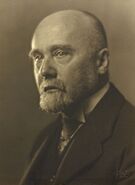 |
Walter Breisky (1871–1944) |
26 January 1922 | 27 January 1922 | 1 day | CS | – | Breisky • CS • GDVP |
||
| (3) |  |
Johannes Schober (1874–1932) |
27 January 1922 | 31 May 1922 | 124 days | IND | – | Schober II • CS • GDVP • Technocrats |
||
| 4 | 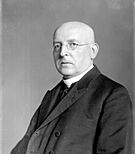 |
Ignaz Seipel (1876–1932) |
31 May 1922 | 20 November 1924 | 2 years, 173 days | CS | 1923 | Seipel I–II–III • CS • GDVP • Technocrats |
||
| 5 | 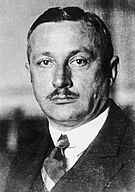 |
Rudolf Ramek (1881–1941) |
20 November 1924 | 20 October 1926 | 1 year, 334 days | CS | – | Ramek I–II • CS • GDVP |
||
| (4) |  |
Ignaz Seipel (1876–1932) |
20 October 1926 | 4 May 1929 | 2 years, 196 days | CS | 1927 | Seipel IV–V • CS • GDVP • LBd |
||
| 6 | 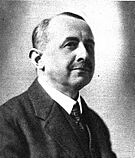 |
Ernst Streeruwitz (1874–1952) |
4 May 1929 | 26 September 1929 | 145 days | CS | – | Streeruwitz • CS • LBd |
||
| (3) | 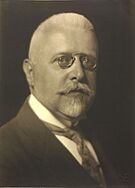 |
Johannes Schober (1874–1932) |
26 September 1929 | 30 September 1930 | 1 year, 4 days | IND | – | Schober III • CS |
||
| 7 | 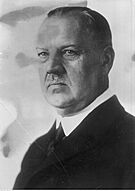 |
Carl Vaugoin (1873–1949) |
30 September 1930 | 4 December 1930 | 65 days | CS | – | Vaugoin • CS |
||
| 8 | 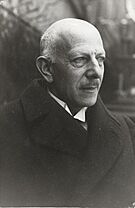 |
Otto Ender (1875–1960) |
4 December 1930 | 20 June 1931 | 198 days | CS | 1930 | Ender • CS |
||
| 9 |  |
Karl Buresch (1878–1936) |
20 June 1931 | 20 May 1932 | 335 days | CS | – | Buresch I–II • CS • LBd |
||
| 10 |  |
Engelbert Dollfuss (1892–1934) |
20 May 1932 | 25 July 1934 † | 2 years, 66 days | CS | – | Dollfuss I • CS • LBd • Heimwehr 20 May 1932 – 1 May 1934 Dollfuss II • VF 1 May 1934 – 25 July 1934 |
||
| VF | ||||||||||
| – | 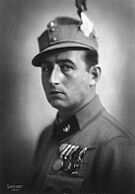 |
Prince Ernst Rüdiger Starhemberg (1899–1956) |
25 July 1934 | 29 July 1934 | 4 days | VF | – | Dollfuss II • VF |
||
| 11 |  |
Kurt Schuschnigg (1897–1977) |
29 July 1934 | 11 March 1938 | 3 years, 225 days | VF | – | Schuschnigg I–II–III–IV–V • VF |
||
| 12 | 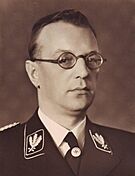 |
Arthur Seyss-Inquart (1892–1946) |
11 March 1938 | 13 March 1938 | 2 days | NSDAP | – | Seyss-Inquart • NSDAP |
||
| Austria was part of Nazi Germany from 13 March 1938 to 27 April 1945 | ||||||||||
| (1) | 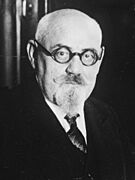 |
Karl Renner (1870–1950) |
27 April 1945 | 20 December 1945 | 237 days | SPÖ | – | Renner IV • SPÖ • ÖVP • KPÖ |
||
| 13 | 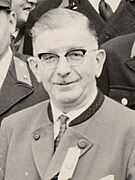 |
Leopold Figl (1902–1965) |
20 December 1945 | 2 April 1953 | 7 years, 103 days | ÖVP | 1945 | Figl I–II–III • ÖVP • SPÖ |
||
| 1949 | ||||||||||
| 14 |  |
Julius Raab (1891–1964) |
2 April 1953 | 11 April 1961 | 8 years, 9 days | ÖVP | 1953 | Raab I–II–III–IV • ÖVP • SPÖ |
||
| 1956 | ||||||||||
| 1959 | ||||||||||
| 15 | 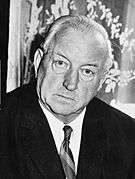 |
Alfons Gorbach (1898–1972) |
11 April 1961 | 2 April 1964 | 2 years, 357 days | ÖVP | 1962 | Gorbach I–II • ÖVP • SPÖ |
||
| 16 |  |
Josef Klaus (1910–2001) |
2 April 1964 | 21 April 1970 | 6 years, 19 days | ÖVP | – | Klaus I • ÖVP • SPÖ |
||
| 1966 | Klaus II • ÖVP |
|||||||||
| 17 | 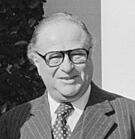 |
Bruno Kreisky (1911–1990) |
21 April 1970 | 24 May 1983 | 13 years, 33 days | SPÖ | 1970 | Kreisky I–II–III–IV • SPÖ |
||
| 1971 | ||||||||||
| 1975 | ||||||||||
| 1979 | ||||||||||
| 18 | 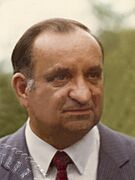 |
Fred Sinowatz (1929–2008) |
24 May 1983 | 16 June 1986 | 3 years, 23 days | SPÖ | 1983 | Sinowatz • SPÖ • FPÖ |
||
| 19 | 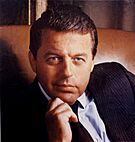 |
Franz Vranitzky (born 1937) |
16 June 1986 | 28 January 1997 | 10 years, 226 days | SPÖ | 1986 | Vranitzky I–II • SPÖ • FPÖ |
||
| 1990 | Vranitzky III–IV–V • SPÖ • ÖVP |
|||||||||
| 1994 | ||||||||||
| 1995 | ||||||||||
| 20 |  |
Viktor Klima (born 1947) |
28 January 1997 | 4 February 2000 | 3 years, 7 days | SPÖ | – | Klima • SPÖ • ÖVP |
||
| 21 |  |
Wolfgang Schüssel (born 1945) |
4 February 2000 | 11 January 2007 | 6 years, 341 days | ÖVP | 1999 | Schüssel I • ÖVP • FPÖ 4 February 2000 – 3 April 2005 Schüssel II • ÖVP • BZÖ 3 April 2005 – 11 January 2007 |
||
| 2002 | ||||||||||
| 22 | 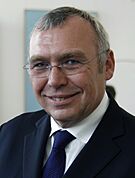 |
Alfred Gusenbauer (born 1960) |
11 January 2007 | 2 December 2008 | 1 year, 326 days | SPÖ | 2006 | Gusenbauer • SPÖ • ÖVP |
||
| 23 | 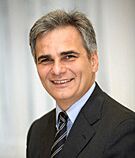 |
Werner Faymann (born 1960) |
2 December 2008 | 9 May 2016 | 7 years, 159 days | SPÖ | 2008 | Faymann I–II • SPÖ • ÖVP |
||
| 2013 | ||||||||||
| – |  |
Reinhold Mitterlehner (born 1955) |
9 May 2016 | 17 May 2016 | 8 days | ÖVP | – | Faymann II • SPÖ • ÖVP |
||
| 24 |  |
Christian Kern (born 1966) |
17 May 2016 | 18 December 2017 | 1 year, 215 days | SPÖ | – | Kern • SPÖ • ÖVP |
||
| 25 |  |
Sebastian Kurz (born 1986) |
18 December 2017 | 28 May 2019 | 1 year, 161 days | ÖVP | 2017 | Kurz I • ÖVP • FPÖ 18 December 2017 – 22 May 2019 • ÖVP 22 May 2019 – 28 May 2019 |
||
| – |  |
Hartwig Löger (born 1965) |
28 May 2019 | 3 June 2019 | 6 days | ÖVP | – | Kurz I • ÖVP |
||
| 26 |  |
Brigitte Bierlein (1949–2024) |
3 June 2019 | 7 January 2020 | 218 days | IND | – | Bierlein • Technocrats |
||
| (25) |  |
Sebastian Kurz (born 1986) |
7 January 2020 | 11 October 2021 | 1 year, 277 days | ÖVP | 2019 | Kurz II • ÖVP • Greens |
||
| 27 | 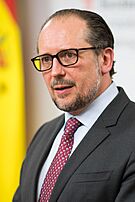 |
Alexander Schallenberg (born 1969) |
11 October 2021 | 6 December 2021 | 56 days | ÖVP | – | Schallenberg • ÖVP • Greens |
||
| 28 |  |
Karl Nehammer (born 1972) |
6 December 2021 | 10 January 2025 | 3 years, 35 days | ÖVP | – | Nehammer • ÖVP • Greens |
||
| – | 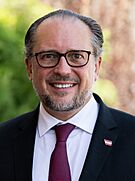 |
Alexander Schallenberg (born 1969) |
10 January 2025 | 3 March 2025 | 52 days | ÖVP | – | Nehammer • ÖVP • Greens |
||
| 29 |  |
Christian Stocker (born 1960) |
3 March 2025 | Incumbent | 294 days | ÖVP | 2024 | Stocker • ÖVP • SPÖ • NEOS |
||
Timeline

See also
- History of Austria
- Politics of Austria
- Elections in Austria
- President of Austria
- List of presidents of Austria
- Vice-Chancellor of Austria
- List of political parties in Austria


